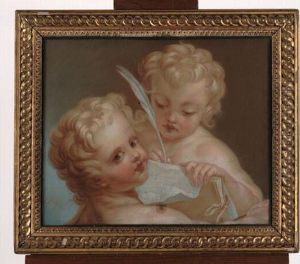Jean Baptiste Ii Lemoyne Paintings
Jean-Baptiste II Lemoyne was a prominent French sculptor born in 1704 in Paris, France. He was part of a renowned family of artists and sculptors, which significantly influenced his career path. Lemoyne was the son of Jean-Louis Lemoyne, also a noted sculptor, which provided him with an artistic environment from an early age. His education in art and sculpture was deeply rooted in the rich cultural heritage of France, and he was trained by his father as well as other notable artists of the time.
Jean-Baptiste II Lemoyne is best remembered for his work in the Rococo style, a movement that emphasized grace, lightness, and elegance. This style was particularly suited to the decorative arts and interior design, but Lemoyne managed to adapt its principles to sculpture in a way that was both innovative and influential. He became a master of portraying delicate subjects, often focusing on mythological themes and figures from classical antiquity, which were imbued with a sense of movement and emotional depth.
Over the course of his career, Lemoyne received numerous commissions from the French aristocracy, including works for King Louis XV. One of his most famous works is the statue of Venus Genitrix, which showcases his skill in capturing the beauty and sensuality of the human form. Lemoyne's influence extended beyond France, as his works were admired and studied by artists across Europe. He played a crucial role in the French Academy of Fine Arts, where he was a respected teacher, shaping the next generation of French sculptors. His teachings emphasized the importance of classical models while encouraging innovation, a philosophy that left a lasting imprint on French sculpture.
Jean-Baptiste II Lemoyne's contributions to sculpture were recognized with numerous honors during his lifetime, and his legacy has endured. He passed away in 1778 in Paris, leaving behind a body of work that continues to be celebrated for its elegance, emotional depth, and technical mastery. Lemoyne's sculptures represent a pivotal moment in the evolution of French art, bridging the gap between the classical traditions of the past and the emerging modern sensibilities of his time.
